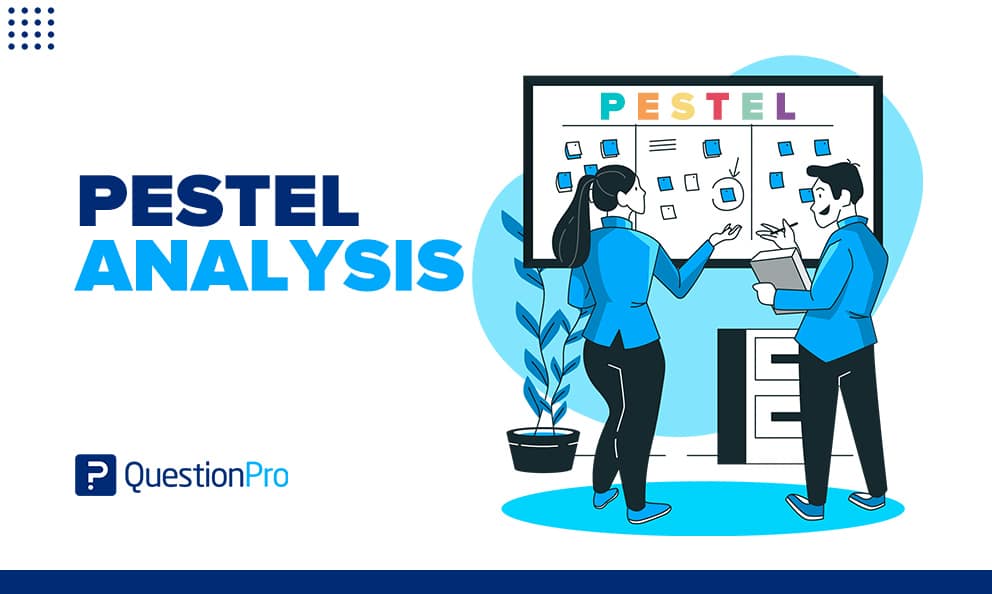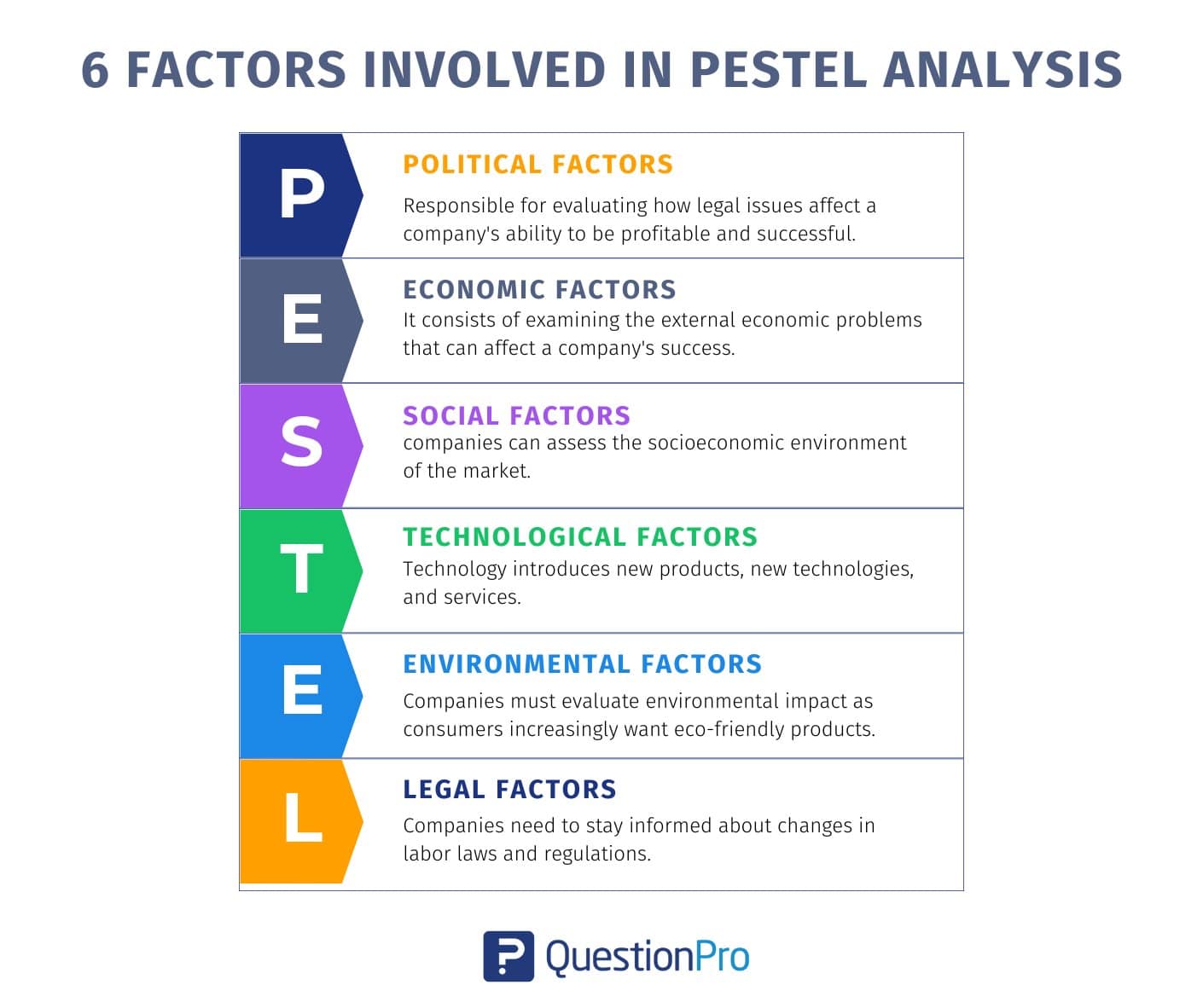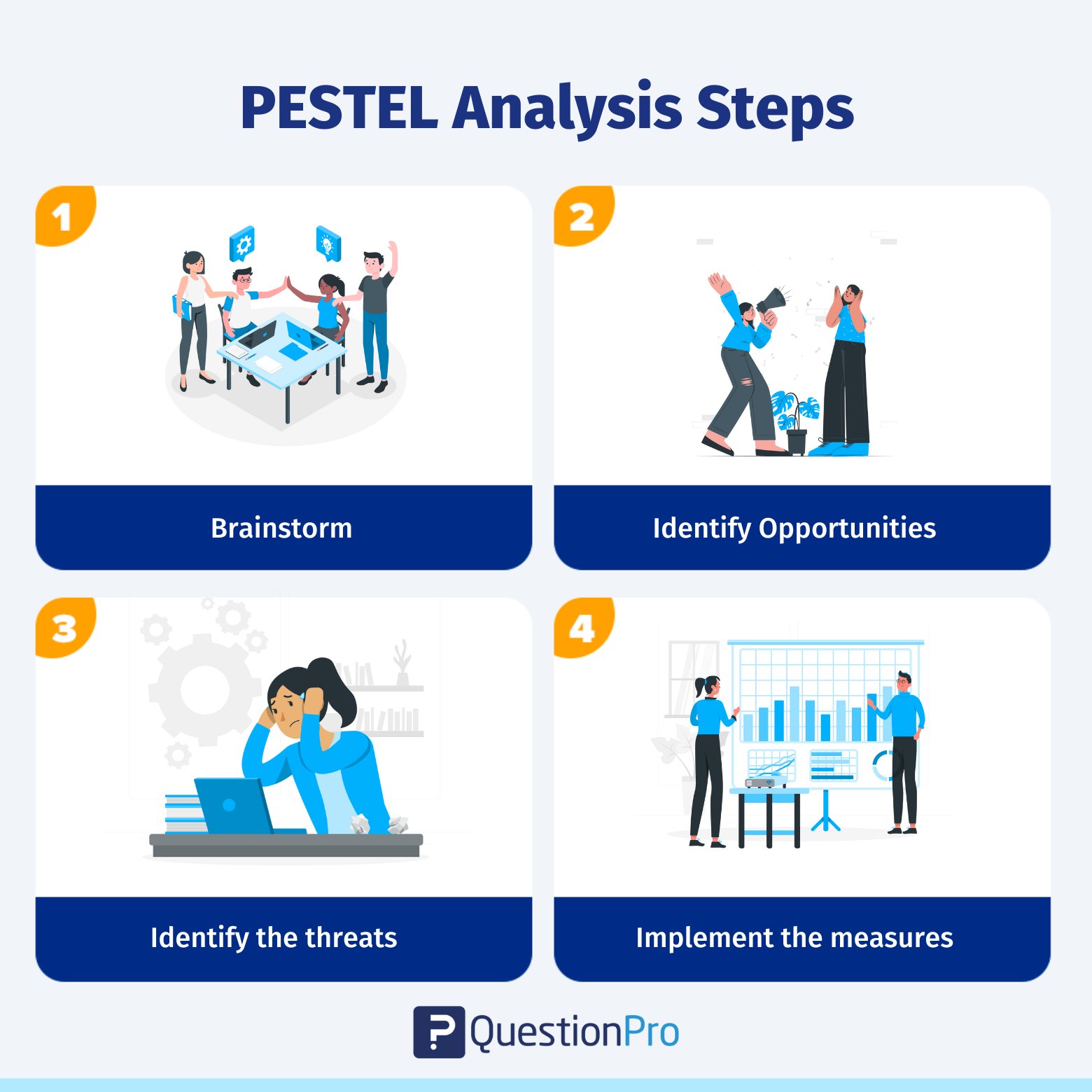
Running a business means navigating constant changes. From new laws to evolving customer preferences, there’s always a lot to manage. That’s where tools like PESTEL analysis come in handy, helping you stay on top of external factors and supporting your growth and success.
Think of it as a handy guide that helps you understand the outside forces affecting your business.
With PESTEL, you can spot potential challenges and find new opportunities to grow. The PESTEL analysis can be instrumental in evaluating the characteristics and changes in the environment that can affect a company’s success, from which the right decisions can be made at the right time.
Are you interested in using this tool? In this blog, we will explain PESTEL analysis, the important factors it covers, and how you can apply it to your business!
What is PESTEL Analysis?
A PESTEL analysis is a tool that allows organizations to discover and evaluate the factors that may affect the business in the present and the future.
PESTEL is an acronym for Political, Economic, Social, Technological, Legal, and Environment. This unit of analysis assesses these four external factors concerning the business situation and examines opportunities and threats arising from them.
With the results offered by the PEST analysis, it is possible to have a favorable view when carrying out market research, creating marketing strategies, developing products, and making better decisions for the organization.
Factors Involved in PESTEL Analysis
As we mentioned before, PESTEL is the acronym for Political, Economic, Social, Technological, Legal, and Environment. Each of these factors can impact your organization at any time, making it essential to conduct analyses that help you anticipate potential threats and make better decisions. Below, we explain each of these factors in detail to guide you through conducting a thorough analysis.

Political Factors
Government regulations and legal issues affect a company’s ability to be profitable and successful. The PEST analysis is responsible for evaluating how this can happen.
Topics to be considered include tax guidelines, copyright and intellectual property law enforcement, political stability, trade regulations, social and environmental analysis policy, labor laws, and safety regulations.
Companies should also consider their local and federal power structure and discuss how anticipated changes in power might affect their business.
Economic Factors
It consists of examining the external economic problems that can affect a company’s success. This factor evaluates different aspects such as interest rates, the change in inflation, unemployment, the gross domestic product, and credit availability.
Social Factors
With the social factor, companies can assess the socioeconomic environment of the market, which allows them to understand how the needs of consumers are formed and what motivates them to make a purchase.
Some aspects that should be evaluated under this aspect include population growth rates, age distribution, attitudes toward work, and labor market trends.
Technological Factors
Technology is essential in business as it can affect them negatively or positively. With the introduction of new products, new technologies, and services, a certain market may find it difficult to adapt, so it is important to evaluate it from all angles.
Specific items to be analyzed include government spending on technology research, current technology’s life cycle, the Internet’s role, and the impact of potential information technology.
Environmental Factors
Companies must evaluate their environmental impact and sustainability practices, as consumers are increasingly prioritizing eco-friendly products. Macro environmental factors include assessing carbon footprints, waste management, and resource conservation strategies, which can influence brand reputation and customer loyalty.
Legal Factors
Companies need to stay informed about changes in labor laws and regulations, including minimum wage laws, workplace safety standards, and employee rights. Non-compliance can lead to legal penalties and affect employee morale.
Advantages of PESTEL Analysis
Performing a PEST analysis has several benefits for the organization, as it allows us to anticipate possible threats. Although certain phenomena that are impossible to predict may appear, having a solid foundation of each aspect that threatens our business plan is a prudent way to operate. If you are not completely convinced, we list some benefits of implementing this type of analysis in your operations below.
- It helps you spot trading opportunities and gives you a warning of significant threats.
- It reveals the change of direction within the organization. This helps you shape your actions to work with the change rather than against it.
- Avoid starting projects that are likely to fail for reasons you can’t control.
- It helps you leave assumptions behind when you enter a new market, allowing you to develop an objective view of this new environment.
- It provides an overview of all the crucial external influences on the organization.
- It supports more decisive and well-informed decision-making.
- Assists in planning, marketing, organizational change initiatives, business and product development, project management, and research papers.
Steps to Perform a PESTEL Analysis
Every organization aiming for success should conduct a PESTEL analysis, and these steps will guide you through the process.

1. Brainstorm
Brainstorm the 4 PEST factors: Political, Economic, Social, and Technological. You can start with a large group of people or break into smaller units and then share their contributions to get an overview.
Among the questions to be answered for each element of the PEST analysis during brainstorming are:
Political Factor
- What government policies or political groups could benefit or harm our success?
- Is the political environment stable, or is it likely to change?
- When are the following local, state, or national elections in the country? How might this change government or regional policy?
- Who are the most likely contenders for power? What are your views on trade policy and other policies that affect the organization?
- How well developed are property rights and the rule of law, and how widespread are corruption and organized crime? How are these situations likely to change, and how is this likely to affect you?
- Could any pending legislation or tax changes affect your business positively or negatively?
- How will business regulation, along with any planned changes, affect your business? And is there a trend towards regulation or deregulation?
- How does the government address corporate policy, corporate social responsibility, environmental issues, and customer protection legislation? What impact does this have, and is it likely to change?
- What is the likely timeline for the proposed legislative changes?
- Are there other political factors that could change?
Economic Factor
- What economic factors will affect us in the future?
- How does the performance of the economy affect us right now?
- How are our prices, income, and costs affected by each economic factor?
- How stable is the current economy? Is it growing, stagnant, or declining?
- Are the key exchange rates stable, or do they vary significantly?
- Are customers’ disposable income levels rising or falling? How is this likely to change in the coming years?
- What is the unemployment rate? Will it be easy to build a skilled workforce? Or will it be expensive to hire skilled labor?
- Do consumers and businesses have easy access to credit? If not, how will this affect your organization?
- How is globalization affecting the economic environment?
- Are there other economic factors I should consider?
Social Factor
- How do the beliefs and values of our customers influence their buying habits?
- How do cultural trends and human behavior play a role in our business?
- What are the population growth rate and age profile? How likely is this to change?
- Are generational changes in attitude likely to affect what you’re doing?
- What are the levels of health, education, and social mobility in your society? How are they changing, and what impact does this have?
- What employment patterns, labor market trends, and attitudes toward work can you observe? Are they different for each age group?
- What social attitudes and taboos could affect the business? Have there been recent socio-cultural changes that could affect this?
- How do religious beliefs and lifestyle choices affect the population?
- Are other sociocultural factors likely to drive change for your business?
Technological Factor
- What technological advances and innovations are available or in the works?
- How will this technology impact our operations?
- Is there any new technology you may be using?
- Are new technologies on the horizon that could radically affect your work or industry?
- Do any competitors have access to new technologies that could redefine their products?
- In what areas do governments and educational institutions focus their research? Is there anything I can do to take advantage of this?
- How have infrastructure changes affected work patterns (for example, levels of remote work)?
- Are there existing tech hubs you could work with or learn from?
- Are there other technology factors I should consider?
2. Identify Opportunities
Once you have identified the changes that are taking place in the business environment, it is time to visualize each of them and brainstorm the opportunities that this could open up for your organization.
This step allows the relevant people to get involved and offer their opinions. Subsequently, group similar ideas and eliminate duplicates. You will be able to draw significant conclusions.
3. Identify the Threats
It’s essential to think about how these changes might affect your business. If you understand this early enough, you can avoid these problems or minimize their impact.
For example, if a core part of the market is in demographic decline, could you open up other market areas? Or, if the technology threatens an essential product, can you harness that technology and improve the product?
Let your employees rate each idea based on the impact they think it will have on the organization. Discuss the significant differences in ratings ask them to explain their reasoning, and test those ideas again if they have changed their minds.
When everyone thinks about the various factors, they are aligned and will better recognize and understand the challenges others face.
4. Implement The Measures
Create the actions you will take to exploit significant opportunities in your business plan, and take appropriate steps to identify significant risks, manage them, and eliminate them.
Where you have identified significant risks, take appropriate steps to manage or eliminate them.
The PESTEL analysis provides a comprehensive overview of the organization’s opportunities and threats now and in the future. Share the results with relevant stakeholders and use the report to monitor progress.
It is necessary to repeat the process regularly to stay abreast of changes in the external environment and keep strategies and plans up to date.
Tips for Performing a PESTEL Analysis
After knowing what the PEST analysis is and the steps to carry it out, we have some tips for you that will help you execute this process effectively:
- Carefully select participants to provide expert knowledge and a fresh customer perspective.
- Use technology to engage essential people in different places and not lose their input.
- Minimize groupthink by brainstorming individually and combining the problems to get the big picture.
- Offer specific ideas rather than general ideas.
- Use quantitative data when possible to focus on a specific issue.
- Provide adequate time in the session to sort and prioritize ideas.
- Communicates the results to stakeholders and regularly updates the analysis process.
Conclusion
PESTEL analysis is ideal for all organizations that want to understand and measure current and future markets. It is essential to mention that an organization’s approach to each factor in the PESTEL analysis depends on the sector in which they focus.
With a PESTEL analysis, companies can visualize the risks and make the most of the business opportunities in the market. If you want to know the best methodologies and tools for decision-making, we invite you to learn everything you need to identify the best opportunities for business success.
Frequently Asked Questions (FAQs)
PESTEL analysis helps businesses identify and understand external factors that can affect their operations. By examining political, economic, social, technological, environmental, and legal factors, organizations can make informed strategic decisions and better navigate challenges.
To conduct a PESTEL analysis, gather information about each of the six factors, analyze how they impact your business, prioritize the most significant factors, and develop strategies based on your findings. Regularly review and update your analysis to stay current with changes in the external environment.
A PESTEL analysis should be reviewed regularly—ideally annually or whenever there are significant changes in the business environment. This ensures that your strategies remain relevant and responsive to new challenges and opportunities.
While both PESTEL and SWOT analyses are strategic tools, they focus on different aspects. PESTEL analyzes external factors affecting the business, whereas SWOT (Strengths, Weaknesses, Opportunities, Threats) examines internal strengths and weaknesses alongside external opportunities and threats.
One limitation is that PESTEL analysis can be time-consuming and may require access to extensive data. Additionally, it doesn’t account for all possible factors affecting a business, so it should be used in conjunction with other analytical tools for a comprehensive view.







